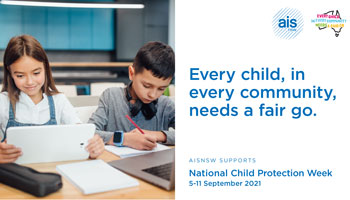Child Protection Week gives us a timely reminder to ensure students are kept safe both online, offline and during remote learning, writes MARIA COSTA.
As many schools continue to deliver teaching and learning remotely in these unprecedented times, the pandemic and COVID restrictions have changed the way we engage with our students. We know staff in schools have done an outstanding job transitioning to online learning.

AISNSW is running a social media campaign to support Child Protection Week.
We encourage and support schools to keep their students and staff safe through education and training including their parent community about risks in an online environment.
We also know that students are spending increased time online due to remote learning and the use of digital technologies to communicate with students and for students to communicate with their peers. This, in turn, has increased the risk of students being exposed to inappropriate material or inappropriate behaviour by adults and peers.
We must continue to be vigilant and aware of what it means to engage safely online for our students and staff. We need to be mindful of how to support our students, families and staff wellbeing during these challenging times.

Increased time online increases students' risk to exposure of inappropriate material.
We encourage and support schools to keep their students and staff safe through education in Personal Development, Health and Physical Education (PDHPE) K-10 in addition to staff training including educating their parent/care community about risks in an online environment. These risks include online grooming, sexting and cyberbullying. Knowing how to avoid harm, identify harm, and then how to manage these risks will minimise opportunities for online harm to occur.
Implementation of Child Safe Standards
Schools are required to demonstrate implementation of the Child Safe Standards to create safe environments and culture at their school. Specifically, Standard No.8, which requires that ‘Physical and online environments minimise the opportunity for abuse or other kinds of harm to occur'.
The Best Practice Framework for Online Safety Education, developed by the Office of the eSafety Commissioner, offers a first-time national approach for online safety education, one that supports schools to deliver effective education and provide consistent advice to their school communities.

Schools need to ensure they have robust and up-to-date policies.
Robust school policies
Schools need to ensure they have robust and up-to-date policies and procedures to assess the risk for students and staff to prevent harm from occurring. To safely manage student and staff behaviour online, we recommend you access the resources found on the AISNSW website Learning from Home portal and the e-Safety Commission suite of resources that support schools to create safer online environments.
The Best Practice Framework for Online Safety Education, developed by the Office of the eSafety Commissioner, offers a first-time national approach for online safety education, one that supports schools to deliver effective education and provide consistent advice to their school communities. The framework makes direct links to eSafety classroom resources, the Australian Student Wellbeing Framework and eSafety’s Toolkit for Schools. You can find this framework as part of the suite or resources in the Whole-School Wellbeing section of the Learning from Home Portal.
Staff in schools also need to be aware of how to identify and report when a student is at risk of online harm or when a student has been harmed online.

Staff in schools also need to be aware of how to identify and report when a student is at risk of online harm.
No cost resources are available for all schools
The eSafety Commission provides a variety of age-appropriate resources to draw on for students, parents and schools to support online safety. These resources are available at no cost for all schools to use. They are backed by evidence and support a nationally consistent approach to preventing and responding to online safety issues.
The AISNSW is committed to supporting schools through a whole school approach to online safety and wellbeing by preventing and responding to online harm
Staff in schools also need to be aware of how to identify and report when a student is at risk of online harm or when a student has been harmed online. Staff should always refer to their school’s Child Protection Policies for specific guidance for reporting incidents within the school and to statutory agencies if required. Staff should also be aware of when and how to notify parents as well as ways in which to support students through appropriate wellbeing pathways
The AISNSW is committed to supporting schools through a whole school approach to online safety and wellbeing by preventing and responding to online harm. This helps to ensure a safe, positive, and engaging online environment and experience for their students, staff and their whole school community.
Please visit AISNSW Child Protection for further resources.
New to AISNSW and want to receive AISNSW Education News updates? Click here to register, and select ‘AISNSW Education News’ on the Areas of Interest/Subscriptions page.